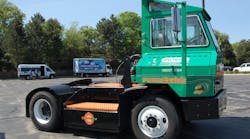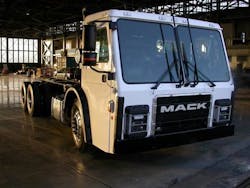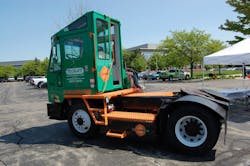For a long while, I’ve harbored big doubts about the ability of all-electric powertrains to deliver the beefy muscle necessary to get commercial trucks through their workday.
Now I’m not so sure.
For example, take the Wrightspeed Route 1000 powertrain now being tested by Mack Trucks on one of its LR refuse models.
Designed as an alternative driveline, the Wrightspeed Route is a range-extended electric powertrain that helps reduce fuel consumption and vehicle maintenance costs, according to Ian Wright, CEO and founder of Wrightspeed.
This particular propulsion package features an advanced plug-in-capable battery paAdditional recharging comes from the system’s 730 kW regenerative braking system, which generates electricity as the vehicle comes to a stop. Regenerative braking helps cut down on maintenance costs by decreasing brake wear.
But what about the torque necessary to stop and start trash trucks? Wright said electricity from the battery pack fires up four Geared Traction Drive (GTD) electric motors, enabling the firm’s system to power vehicles up to 66,000 pounds on grades as steep as 40%. With full torque available from zero rpm, the Route provides a driving experience comparable to diesel-powered trucks, Wright explained.
Electricity also seems to be getting the job done where terminal tractors are concerned as well.
Moran Transportation Corp. brought its all-electric Orange EV yard tractor to the 2016 Green Drives Conference held in Naperville, IL, last month; a unit already in service alongside two diesel-powered models at the company’s distribution center near Chicago O’Hare International Airport.
Robert Petzold, Moran’s vice president, told me that his company can operate its Orange EV tractor on just $5 worth of electricity during its 20 hour shift, coPetzold told that while grant money defrayed part of the cost of acquiring the tractor – lowering the price Moran had to pay by almost half to just under $50,000 – the driver-friendly features of the Orange EV convinced his company to acquire a second unit and maybe possibly a third as well.
“First the battery and electric motor sit between the wheels, so it [the tractor] rides much better compared to the diesel model, where the engine and all the weight is up front,” Petzold explained. “It also doesn’t produce a lot of heat so it’s much cooler to operate in the summer.”
Yet in the winter, the Orange EV’s infrared heating system quickly warms the cab and keeps windows free from ice and snow, he stressed.
“That’s because the short trips these tractors go on doesn’t give diesels time to warm up enough to produce enough heat in the winter,” Petzold said.
I’m not saying that electricity is necessarily a slam-dunk now for truckers. Indeed, it’s still very application-specific, as yard mules and trash trucks don’t accrue the high-speed highway miles long haul tractors do.
Still, the technology and the cost savings are there and that’s a good thing as truckers must always keep an eye on the bottom line.





